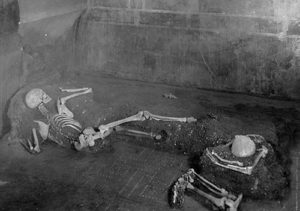It’s the latest example of how genetic technologies have advanced to the point where DNA can be extracted and sequenced from human remains that are thousands of years old, often generating new insights that can benefit clinical laboratory testing
How might an individual in Pompeii who died in the famous Mount Vesuvius volcanic eruption of 79 AD help medical science today? The answer is that sequencing this individual’s DNA may yield insights into health conditions and infectious diseases of that era that could help scientists better understand disease today in ways that improve diagnosis and clinical laboratory testing.
Additionally, researchers studying genetic sequencing are discovering the technology has many more capabilities that previously thought. One such example involves scientists from the University of Copenhagen, the University of Salento, and victims of the eruption. This research team has determined that even severely damaged biological samples may contain viable DNA.
When Mount Vesuvius erupted, volcanic ash and pumice buried many residents of the town of Pompeii in southern Italy. The ash was estimated to have been about 500 degrees Fahrenheit, which should have been hot enough to cause significant damage to DNA. However, it appears the pyroclastic materials released during the eruption may instead have preserved some of the victims’ DNA.
“One of the main drivers of DNA degradation is oxygen (the other being water),” Gabriele Scorrano, PhD, Assistant Professor, University of Copenhagen and lead author of the study told CNN. “Temperature works more as a catalyst, speeding up the process. Therefore, if low oxygen is present, there is a limit of how much DNA degradation can take place.”
The scientists succeeded in performing completed genetic sequencing on one of the victims of the violent eruption. This has genetic researchers rethinking how DNA could be recovered from damaged biological materials.
The researchers published their findings in the journal Nature Scientific Reports, titled, “Bioarcheological and Paleogenomic Portrait of Two Pompeiians That Died During the Eruption of Vesuvius in 79 AD.”

“In the future, many more genomes from Pompeii can be studied,” anthropologist Serena Viva, PhD (above), a postdoctoral researcher at the University of Salento in Italy and one of the authors of the study told the Guardian. “The victims of Pompeii experienced a natural catastrophe, a thermal shock, and it was not known that you could preserve their genetic material. This study provides this confirmation, and that new technology on genetic analysis allows us to sequence genomes also on damaged material.” What new clinical laboratory testing may come out of this study is not known. But it shows that there is still much to learn about genetic sequencing. (Photo copyright: University of Salento.)
Findings Suggest High Levels of Genetic Diversity
“There was the expectation that the high temperatures would make our effort in DNA sequencing in Pompeii fruitless,” Scorrano stated. “Cremated bodies, for example, show no sign of DNA preservation according to multiple studies.”
The scientists examined the skeletal remains of two victims found in a building known as Casa del Fabbro or House of the Craftsman to determine if any DNA was present. One skeleton was that of a man in his 30’s who was about five feet four inches in height and the other skeleton was of a woman who appeared to be at least 50 years of age and around five feet tall.
Although the researchers did obtain genetic material from both skeletons, they were only able to sequence the entire genome from the remains of the male skeleton.
The researchers compared his DNA with that of 1,030 other ancient and 471 modern western Eurasian people. The results suggest that the DNA from the male Pompeii skeleton shares the most similarities with people who currently live or lived in central Italy in the past.
Further analysis of the man’s DNA identified groups of genes that are commonly found in people from the island of Sardinia, but not in other people who lived in Italy during the Roman Imperial age. This suggested to the researchers that there may have been high levels of genetic diversity across Italy in 79 AD when Mount Vesuvius erupted.
Additional testing also identified sequences that are commonly found in a group of bacteria known to cause tuberculosis of the spine (Pott disease), a common ailment at that time. This implies the man had the illness when he perished.

The photo above shows the two skeletons (one man and one woman) found in Pompeii’s Casa del Fabbro. Though the University scientists tried to extract full sequences from both skeletons, they only succeeded with the male. (Photo copyright: Notizie degli Scavi di Antichità, 1934, p. 286, fig. 10.)
First Pompeiian Genetic Sequence
Scientists had attempted to sequence DNA from Pompeiian victims before, but previous endeavors to analyze more than small DNA strands failed.
“To our knowledge, our results represent the first successfully sequenced Pompeiian human genome,” they wrote in Nature Scientific Reports. “Our initial findings provide a foundation to promote an intensive and extensive paleogenetic analysis in order to reconstruct the genetic history of population from Pompeii, a unique archaeological site.”
It is unclear how equivalent studies could fare in the future, but the researchers involved in this study hope to use their sequencing techniques on other remains. It is possible that DNA from this Roman man who died in Pompeii in 79 AD may be used to determine if he has any descendants living today.
Other Genetic Sequencing of Ancient Skeletons
In 1997, researchers from the Natural History Museum in London and Oxford University extracted mitochondrial DNA from a tooth of a skeleton from a Stone Age man known as “Cheddar Man.” That skeleton was found near a village called Cheddar in the Somerset region of southwest England.
After months of research and the charting of Cheddar Man’s DNA, the scientists visited a school in Cheddar to extract DNA samples from schoolchildren and look for DNA matches. About 20 samples were taken in total including one from a teacher named Adrian Targett.
“They wanted to take DNA samples from some of the students whose families had lived longest in the area,” Targett told the Los Angeles Times. “I gave a [cheek swab] sample too, just to encourage the children and to make up the numbers.”
Although none of the children were a genetic match to the Cheddar Man, Targett was identified as a direct descendant of the skeleton.
“It’s a bit frightening to think that there are all those links across all those generations,” Targett said. “But the nice thing is that there are links that are so strong. We are all descended from an ancestor like Cheddar Man. Who knows how many people we are related to and don’t know about?”
The Pompeii DNA research is the latest example of how the ongoing reduction in the cost, faster throughput, and increased accuracy of genetic sequencing is allowing scientists to gain new knowledge from ancient artifacts. In turn, some of these new insights may lead to improving how certain health conditions are diagnosed, possibly using novel clinical laboratory tests developed as a result of this research.
—JP Schlingman
Related Information:
An Ancient Roman Who Died in Pompeii Has Had [His] Genome Sequenced
First Human Genome from Pompeii Sequenced
This Man Was Encased in Volcanic Ash in Pompeii. Here’s What His DNA Reveals
Pompeii Victim’s Genome Successfully Sequenced for First Time



